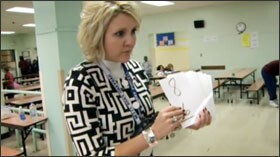A documentary following two Illinois principals and accompanying outreach materials are aimed at elevating the attention paid to school leaders.
“The Principal Story,” a 56-minute film that chronicles the triumphs and travails of a veteran and a novice principal over a school year, premieres on PBS this week as part of its “P.O.V.” series of independent documentaries. The national air date is Sept. 15 at 10:30 p.m. Eastern time; the program will be rebroadcast at various times.

Lucas B. Held, the communications director for the New York City-based Wallace Foundation, which financed the documentary, said the film came about as a result of the foundation’s work over the past decade promoting improvements in school leadership.
Research funded by Wallace has found that the quality of a school leader is second only to teacher quality in determining school effectiveness, Mr. Held noted, but foundation officials have found a lack of understanding of that research. (The Wallace Foundation also provides funding to Education Week for coverage of school leadership.)
“Too often, people see the school principal as the keeper of the keys, the man or woman who makes the buses run on schedule and ensures that the services are being provided, that the food is being served, and that the children are safe,” Mr. Held said. “Of course, all these are important, but they miss the essential role of the principal as the leader of the team that drives instructional improvement. It was really our hope in commissioning this film to help overcome this gap in understanding.”
Print, Video Resources
To try to bridge that gap, the foundation is releasing print and video resources along with the documentary that are aimed at a variety of audiences. One guide, written in collaboration with a variety of national groups, including the Council of Chief State School Officers and the National Governors Association, describes key policy issues raised in the video and offers discussion questions on policy actions to consider.
A “field guide” to the film, produced by the Dallas-based National Staff Development Council, aims to promote professional learning among aspiring and practicing school leaders and their trainers, supervisors, and mentors.
The materials also include vignettes of four “leadership innovations” supported by the Wallace Foundation as ideas for states and districts to consider. They include creating positions for “school administration managers” to take the management load off principals and allow them to focus on instruction, and improving principal training, as initiatives in New York City and Atlanta have aimed to do.
The Wallace Foundation has given grants to PBS stations in more than a dozen cities to produce mini-documentaries on the schools in their coverage areas as companion pieces to “The Principal Story.”
The film features second-year principal Tresa D. Dunbar of Chicago’s long-struggling Henry H. Nash Elementary School and Kerry Purcell, who was in her sixth year as principal at Harvard Park Elementary School in Springfield,Ill. They are shown going through their days, interacting with students in the classroom, and talking to teachers about how to improve their classrooms.
“We’ve been on probation for 12 years. Aren’t you tired? Let’s get this together,” Ms. Dunbar tells staff members at a meeting where she pushes them to spend more time understanding the needs of each child.
Tough Decisions
The film doesn’t shy away from showing the more unpleasant parts of a principal’s job. In one scene, Ms. Purcell finds herself having a difficult conversation with a group of Harvard Park 1st graders after a classmate is struck and killed while riding his bicycle.
“When you do a project like this, there is no dog-and-pony show you can put on, because these folks become part of the culture and climate,” Ms. Purcell said in an interview. “Everyone works together to support kids. I thought it was a wonderful way to capture that.”
Ms. Dunbar is shown deciding to let go of a low-performing teacher after trying a number of strategies to help the teacher improve classroom discipline.
“This is a hard job. When you’re getting rid of someone, they are losing their livelihood,” the Nash Elementary principal says in the film. “I don’t want to be responsible for that unless I have to, but when I have to, it happens.”
U.S. Secretary of Education Arne Duncan, who was then the chief executive officer of Chicago’s schools, appears in the documentary and explains the varied qualities principals need to do the job.
“At the end of the day, what I really measure is our principals’ hearts,” Mr. Duncan says. “How much do they believe that our children can be successful?”




